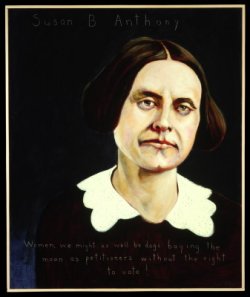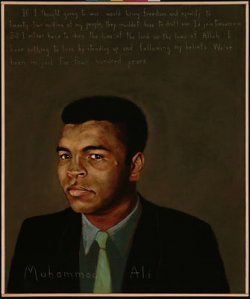Robert Shetterly
“Americans Who Tell the Truth” Exhibit of 238 portraits opens at Syracuse University
The portrait series by artist Robert Shetterly highlights citizens who courageously address issues of social, environmental and economic fairness. The artist will participate in a public discussion at the University on November 29.
Shetterly was born in Cincinnati and graduated from Harvard College in 1969 with a degree in English literature. After moving to Maine in 1970, he taught himself drawing, printmaking and painting. While trying to become proficient in printmaking and painting, he illustrated widely. For 12 years he created the editorial page drawings for the Maine Times newspaper and illustrated the National Audubon Society’s children’s newspaper, Audubon Adventures and some 30 books.
His work appears in collections across the United States and Europe. Along with his “Americans Who Tell the Truth” series, he is well known for his series of 70 painted etchings based on William Blake’s “Proverbs of Hell,” and for another series of 50 painted etchings reflecting on the metaphor of the Annunciation.
He began “Americans Who Tell the Truth” in the early 2000s in response to U.S. government actions following 9/11. Shetterly undertook the project as a way to deal with his own grief and anger by painting Americans who inspired him. He initially intended to paint only 50 portraits, but by 2013 the series had grown to more than 180 paintings. Today, it numbers 238. Portions of the series have toured widely across the United States, shown in schools, museums, libraries, galleries and other public spaces.
A few of Shetterly’s paintings have previously been featured at Syracuse University. A small portion of the “Americans Who Tell the Truth” series was on display in March and April 2014 at VPA’s 914Works gallery.
An “Americans Who Tell the Truth” book featuring Shetterly’s first 50 portraits was published in 2008. He says the portraits have given him an opportunity to speak with children and adults throughout the United States about “the necessity of dissent in a democracy, the obligations of citizenship, sustainability, U.S. history, and how democracy cannot function if politicians don’t tell the truth, if the media don’t report it, and if the people don’t demand it.”
Shetterly is the subject of a documentary that’s in production, “Our Children’s Future: A Portrait of Robert Shetterly,” sponsored by the Union of Maine Visual Artists and directed by SU alumnus Richard Kane ’72. [View the film’s trailer.] Kane will be in Syracuse this week to record additional interviews for the film.
In connection with the exhibit, he will be engaged in a full schedule of classroom appearances at Syracuse University this week, visiting VPA, the Falk College of Sport and Human Dynamics, the School of Education, the Whitman School of Management, and the Renée Crown University Honors Program.
________________________________________
Muhammad Ali
Boxer : b. 1942 – 2016
“If I thought going to war would bring freedom and equality to twenty-two million of my people, they wouldn’t have to draft me. I’d join tomorrow. But I either have to obey the laws of the land or the laws of Allah. I have nothing to lose by standing up and following my beliefs. We’ve been in jail for four hundred years.”
The ESPN network, choosing its top athletes of the 20th Century, placed Muhammad Ali at number 3. The fighter was born Cassius Marcellus Clay Jr. in Louisville, Kentucky. Taught to box at age 12, he won 100 of 108 amateur fights and several national titles. At age 18 he added a gold medal from the 1960 Olympics. Back home in Kentucky, however, when a restaurant refused to serve him because of his race, Clay took the Olympic medal from around his neck and threw it into the Ohio River.
Turning professional, the handsome and skillful Clay brought style and verbal wit to boxing. Both quick and powerful, he could “float like a butterfly and sting like a bee.” In his 20th match, fighting as the underdog, he became the world heavyweight champion. A surprised nation was further shocked the next morning when Clay announced that he had joined the Nation of Islam and taken a Muslim name, Muhammad Ali.
By March 1967, his record stood at 29-0. One month later, he refused induction into the US Army during the Vietnam War, claiming conscientious objector status. “I ain’t got no quarrel with them Viet Cong,” he said, adding, “No Viet Cong ever called me nigger.” Condemned as unpatriotic and cowardly, Ali was stripped of his title and his boxing license. He was tried, found guilty and sentenced to five years in prison. Released on appeal, he waited three years for the U.S. Supreme Court to overturn the verdict.
Despite these years of inactivity, Ali ended his professional career with a record of 56 wins and 5 losses. Revered instead of hated, he became the first boxer to win—and hold–the heavyweight championship three times (1964-67, 1974-78 and 1978-79). But he stayed too long in the ring and lost three of his last four fights before retiring in 1981. Shortly after that, he was diagnosed with Parkinson’s disease.
Two decades later, Ali has been slowed by the disease but not defeated. Three decades after America reviled him for his religious and political beliefs, he was asked to light the Olympic Torch at the opening of the 1996 Atlanta games. In October 2003, the editor of Esquire magazine wrote that “he, like only a very few Americans, has existed for nearly his entire life at that rare nexus of celebrity, accomplishment, and infamy that makes one an American icon.”
________________________________________

Susan B. Anthony
Reformer, Woman-Suffrage Leader: 1820-1906
“Women, we might as well be dogs baying the moon as petitioners without the right to vote!”
Susan Brownell Anthony’s life dedicated to social reform may have been foreordained by her birth, in Adams, Massachusetts, into the large family of a Quaker abolitionist. Tales of her childhood support the image of the forceful personality that was to emerge on lecture platforms in the 1850’s. As a young teacher in western New York, Anthony addressed such thorny issues as equal pay for women teachers and broader educational opportunities for girls. The abolition of slavery was, of course, the dominant concern of mid-19th Century reform, and she became acquainted with eminent leaders of the movement such as Frederick Douglass who visited the family home in Rochester.
The temperance movement attracted her support because she, like other feminists of her time, recognized in alcohol abuse the widespread victimization of innocent women and children who had to suffer the physical dangers and economic hardships of living with hard-drinking men. When the Sons of Temperance barred women from their ranks, Anthony organized the Daughters of Temperance.
Anthony’s celebrated collaboration with Elizabeth Cady Stanton dates from their meeting in 1851. Because Stanton’s duties as a wife and mother limited her travel during the 1850’s, Anthony was often the more visible spokesperson for women’s full legal and social equality and, as such, the more frequently ridiculed. In 1872, Anthony decided to test the protection of the 14th Amendment by attempting to register and vote in Rochester. She was arrested, tried and fined, but she refused to pay.
Today, when activists have the benefit of mass media and electronic communications, it is easy to forget the sheer physical exertion involved in the work of reform in years past: travel, writing and distributing newspapers, starting local groups, petitioning legislative bodies, pamphleteering and public speaking. Anthony, a brilliant organizer, averaged 100 speaking engagements each year during her most active period.
She once remarked that, “It has always been thought perfectly womanly to be a scrubwoman in the Legislature and take care of the spittoons; that is entirely within the charmed circle of woman’s sphere: but for women to occupy any of those official seats would be degrading.” She also said: “I distrust those people who know so well what God wants them to do, because I notice it always coincides with their own desires.”






